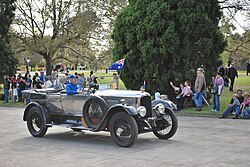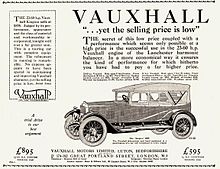Vauxhall 23/60
| Vauxhall | |
|---|---|
|
Vauxhall 23/60 Kington touring car, 5 seats
|
|
| 23/60 | |
| Production period: | 1922-1925 |
| Class : | Upper class |
| Body versions : | Touring car , limousine , Pullman limousine , landaulet , cabriolet |
| Engines: |
Otto engines : 4.0 liters (44 kW) |
| Length: | |
| Width: | |
| Height: | |
| Wheelbase : | 3302 mm |
| Empty weight : | 1372-1626 kg |
| Previous model | Vauxhall 25 |
| successor | Vauxhall 25/70 |
The Vauxhall 23/60 is a full size car , the Vauxhall Motors 1922 manufactured to 1925th He was presented in July 1922. The 23/60 model "Kington" standard touring car was claimed to "get the greyhound look that is so typical of the Vauxhall". The 23/60 had many parts in common with the more powerful 30/98 model .
The 23/60 replaced the Model 25 , which had provided excellent service in the First World War and from which the 23/60 was developed. The construction of the 23/60 was up to the introduction of the 25/70 with its particularly soft running six-cylinder - valve engine continued on 16 November 1925th
Construction and details
Controls
The hand levers for gear shifting and the rear brake are to the right of the driver, but in contrast to the 30/98 and 25 models, there is a separate driver's door. The controls for the ignition advance and the throttle are located on the steering wheel, together with an air lever with which a valve in the intake line (after the throttle slide) is operated. There is also a mixture control ( choke ) on the dashboard. The levers for the gear shift and the brake are easy to operate. The accelerator pedals and the (transmission) brake are close together.
The top is an all-weather version, the upper door parts (window and frame) are stored in a cover behind the rear bench seat.
Large tools are located in the footrest and a tool box is attached to the left (passenger) running board.
engine
The 23/60 has a four-cylinder in - line engine with a displacement of 3969 cm³ (bore × stroke = 95 mm × 140 mm), which runs at 2000 1 / min. delivers an output of 60 bhp (44 kW). It is equipped with a Zenith carburettor with a triple diffuser and is fed by an Autovac storage tank. The engine block is made of gray cast iron and the crankcase is made of aluminum.
The engine is essentially similar to that of the previous Model 25. The chief engineer CE King provided it with a new cylinder head with overhead valves and balancer shafts , as invented by Frederick W. Lanchester . In such large vehicles, six-cylinder engines were already common at that time because of the smoother engine running . The balance shafts were at the level of the crankshaft .
The alternator is driven by the flywheel (in the clutch housing). The alternator, magneto and carburetor with the intake line heated by cooling water and the vacuum tank on the bulkhead are on the left side of the engine, the starter, the steering gear, the exhaust manifold, the dipstick and the oil filler neck on the right side of the engine. The water jacket in the lower part of the engine block is connected to the cylinder head via large copper pipes. A one-piece cylinder head gasket is installed between the engine block and the cylinder head.
Lanchester balance shafts
The Lanchester balance shafts ( Lanchester Harmonic Balancer ) on the crankshaft have two balanced drums and rotate twice as fast as the crankshaft. One of them is driven by the crankshaft via helical spur gears and drives the second, also via gears. The balance shafts counteract unwanted vibrations.
Only a few of the cars that have survived to this day still have the balance shafts.
Power transmission
The gearshift lever sits on the driver's right side. The clutch support and release bearings are oiled by hand; to get there, the aluminum floor panels must be unscrewed at the front. The multi-plate clutch is operated with graphite (as a lubricant) and is connected to the four-speed transmission by a fabric connection. The engine power is then passed on to the worm gear on the rear axle. The rear axle is held in place by torsion bars .
landing gear

brakes of the 23/60 "Four-wheel brake with independent rear-wheel brake on separate brake drums"
"The balancing mechanism of the Vauxhall front wheel brakes is easy to understand: A is the brake rod from the pedal, which rotates cam C via shaft B, at the two opposite ends Brake cables are attached that actuate the brake shoes.
The cam B, which can tilt slightly, immediately finds its true center through the slightest resistance and so the brake shoes engage on both sides with the same force at the same time. "
The manufacturer has a three-year guarantee for the chassis and its mechanics.
Brakes
The foot brake acts on the gearbox and the handbrake acts on the rear wheels. Both are drum brakes. The foot brake is adjusted by hand, but a wrench is required to adjust the rear brakes.
Twelve months after the launch of the 23/60, front brakes were available at an extra cost of £ 55. Another year later, from July 1924, they became standard equipment on the cars, along with a new front axle, springs and a fifth wheel. The front wheel brakes were operated with the same pedal that was previously only responsible for the transmission brake and were connected to it, whereby this came into action a little earlier. The rear brakes were still operated independently with the handbrake lever.
steering
The wagons had a worm steering .
Suspension
Both axes hang on semi-elliptical springs.
Superstructures Offered (October 6, 1922)
- Chassis: £ 695.
- 'Kington' touring car, 5 seats: £ 895.
- All Weather 'Arundel': £ 1145.
- 'Salisbury' Pullman limousine: £ 1220.
- 'Carlton' Pullman linousine: £ 1270.
- Warwick landaulet: £ 1195.
- 'Grosvenor' linousine: £ 1175.
- 'Winchester' linousine: £ 1275.
- 'Sutherland' convertible: £ 1200.
- Langham landaulet (closed): £ 1300.
Individual references and comments
- ↑ a b c d e f g h i j k l Cars of To-Day in The Times , September 26, 1922. p. 16.
- ^ A b c d David Culshaw, Peter Horrobin: The Complete Catalog of British Cars, 1895–1975 . Veloce Publishing, Dorchester 1999. ISBN 1-874105-93-6 . P. 332.
- ^ A b Vauxhall in The Times , July 7, 1922. p. 13.
- ↑ Display advertisement: The Future of Vauxhall Motors by managing directors L Walton and PC Kidner in The Times , November 26, 1925. p. 10.
- ↑ The gasoline from the main tank is drawn into the Autovac storage tank on the dashboard with the help of the vacuum from the intake. From there it runs through gravity into the carburetor.
- ↑ a b c Cars of To-Day in The Times , December 16, 1924. p. 7.
- ^ Vauxhall in The Times , July 16, 1924. p. 13.
- ↑ Display advertisments: Vauxhall Cars in The Times , October 24, 1922. p. 7.
- ↑ Display advertisments: Vauxhall Motors Ltd in The Times , April 16, 1923. p. VI.
- ^ Vauxhall in The Times , October 16, 1924. p. 11.


